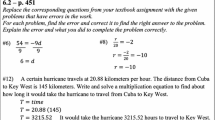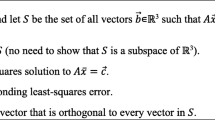Abstract
To improve students’ mathematics achievement, their errors should be treated as an opportunity to stimulate conceptual and procedural understanding. Using a teaching scenario, this study investigated 40 high school teachers’ analyses of and responses to a student error(s) in solving a quadratic equation by using the factoring method. The teachers’ responses were analyzed quantitatively and qualitatively. Analyses results revealed a gap between identified errors and addressed ones, as well as a gap between interpreting a knowledge weakness and explaining a knowledge focus. While the errors came from conceptual aspects of the factoring method, most of the participants offered conceptual explanations addressed in a teacher-centered way. The results also revealed that student errors and mathematical knowledge were two foci of the teachers’ responses to students. The broader implications of the study for the international community are discussed in accordance with the findings.

Similar content being viewed by others
References
Adler, J., & Davis, Z. (2006). Opening another black box: Researching mathematics for teaching in mathematics teacher education. Journal for Research in Mathematics Education, 37(4), 270–296.
An, S., Kulm, G., & Wu, Z. (2004). The pedagogical content knowledge of middle school, mathematics teachers in China and the US. Journal of Mathematics Teacher Education, 7(2), 145–172.
An, S., Kulm, G., Wu, Z., Ma, F., & Wang, L. (2006). The impact of cultural differences on middle school mathematics teachers’ beliefs in the US and China. In F. K.-S. Leung, K.-D. Graf, & F. J. Lopez-Real (Eds.), Mathematics education in different cultural traditions-A comparative study of East Asia and the West (pp. 449–464). Springer US.
Blume, G. & Heckman, D. (1997). What do students know about algebra and functions? Retrieved from zentralblatt-math.org.
Borasi, R. (1994). Capitalizing on errors as ‘springboards for inquiry’: A teaching experiment. Journal for Research in Mathematics Education, 25(2), 166–208.
Clements, M. A., & Ellerton, N. F. (2006). Improving prospective mathematics teachers’ understanding of the solution process for quadratic equations in the form (x - a) (x - b) = 0. In H. S. Dhindsa, I. P. Cheong, I. J. Kyeleve, O. Chukwu, & J. S. H. Q. Perera (Eds.), Shaping the future of science, mathematics and technical education (pp. 287–296). Gadong, Brunei Darussalam: Universiti Brunei Darussalam.
Correa, C. A., Perry, M., Sims, L. M., Miller, K. F., & Fang, G. (2008). Connected and culturally embedded beliefs: Chinese and US teachers talk about their students best learn mathematics. Teaching and Teacher Education, 24(1), 140–153.
Crooks, N. M., & Alibali, M. W. (2014). Defining and measuring conceptual knowledge in mathematics. Developmental Review, 34(4), 344–377. https://doi.org/10.1016/j.dr.2014.10.001.
Didiş, M., Baş, S., & Erbaş, A. (2011). Students’ reasoning in quadratic equations with one unknown. In M. Pytlak, T. Rowland, & E. Swoboda (Eds.), Proceedings of the 7th Congress of the European Society for Research in Mathematics Education (pp. 479–489). Rzeszów, Poland: ERME.
Drijvers, P., Goddijn, A., & Kindt, M. (2010). Algebra education: Exploring topics and themes. In P. Drijvers (Ed.), Secondary algebra education (pp. 5–26). Sense Publishers.
Ellerton, N. F., & Clements, M. K. (2011). Prospective middle-school mathematics teachers’ knowledge of equations and inequalities. In J. Cai & E. Knuth (Eds.), Early Algebraization (pp. 379–408). New York: Springer.
Eraslan, A. (2005). A qualitative study: Algebra honor students’ cognitive obstacles as they explore concepts of quadratic functions (Doctoral dissertation). Retrieved from ProQuest Dissertation and These Database. (3216591).
Fujii, T. (2003). Probing students’ understanding of variables through cognitive conflict: Is the concept of a variable so difficult for students to understand? In N. A. Pateman, B. J. Dougherty, & J. Zilliox (Eds.), Proceedings of the 2003 joint meeting of the PME and MNENA (Vol. 1, pp. 49–65). Honolulu: International Group for the Psychology of Mathematics Education.
Gagatsis, A., & Kyriakides, L. (2000). Teachers’ attitudes towards their pupils’ mathematical errors. Educational Research and Evaluation, 6(1), 24–58.
Grossman, P., & Mcdonald, G. M. (2008). Back to the future: Directions for research in teaching and teacher education. American Educational Research Journal, 45(1), 184–205.
Hill, H. C., Ball, D. L., & Schilling, S. G. (2008). Unpacking pedagogical content knowledge: Conceptualizing and measuring teachers’ topic-specific knowledge of students. Journal for Research in Mathematics Education, 39(4), 372–400.
Hu, Q. (2014). The algebraic thinking of mathematics teachers in China and the U.S. (Unpublished doctoral dissertation). The University of Tennessee, Knoxville.
Huang, R., & Kulm, G. (2012). Prospective middle grade mathematics teachers’ knowledge of algebra for teaching. The Journal of Mathematical Behavior, 31(4), 417–430.
Jakwerth, P. (1999). TIMSS performance assessment results United States. Studies in Educational Evaluation, 25(3), 277–281.
Kieran, C. (2007). Learning and teaching algebra at the middle school through college levels: Building meaning for symbols and their manipulation. In F. K. Lester (Ed.), Second Handbook of Research on Mathematics Teaching and Learning (pp.707-62). Charlotte, NC: Information Age Publishing.
Kotsopoulos, D. (2007). Unravelling student challenges with quadratics: A cognitive approach. Australian Mathematics Teacher, 63(2), 19–24.
Ladson-Billings, G. (1995). Toward a theory of culturally relevant pedagogy. American Educational Research Journal, 32(3), 465–491.
Li, X. (2006). Cognitive analysis of students’ errors and misconceptions in variables, equations, and functions (Doctoral dissertation). Retrieved from ProQuest Dissertation and Thesis Database.
Lim, T. H. (2000). The teaching and learning of algebraic equations and factorization in O-level Mathematics: A case study (Unpublished M.Ed dissertation). University Brunei Darussalam, Brunei.
Matz, M. (1982). Towards a process model for high school algebra. Intelligent Tutoring Systems, 1(1), 20–30.
National Council of Teachers of Mathematics. (2000). Principles and standards for school mathematics (Vol. 1). National Council of Teachers of Mathematics.
Peng, A., & Luo, Z. (2009). A framework for examining mathematics teacher knowledge as used in error analysis. For the learning of mathematics, 29(3), 22–25.
Radatz, H. (1980). Students’ errors in the mathematical learning process: A survey. For the Learning of Mathematics, 1(1), 16–20.
Rittle-Johnson, B., & Alibali, M. W. (1999). Conceptual and procedural knowledge of mathematics: Does one lead to the other? Journal of Educational Psychology, 91, 175–189.
Schleppenbach, M., Flevares, L. M., Sims, L. M., & Perry, M. (2007). Teachers’ responses to student mistakes in Chinese and US mathematics classrooms. The Elementary School Journal, 108(2), 131–147.
Seifried, J., & Wuttke, E. (2010). Student errors: How teachers diagnose and respond to them. Empirical research in vocational education and training, 2(2), 147–162.
Senk, S. L., Tatto, M. T., Reckase, M., Rowley, G., Peck, R., & Bankov, K. (2012). Knowledge of future primary teachers for teaching mathematics: An international comparative study. ZDM, 44(3), 307–324.
Shen, S., Sullivan, H., Igoe, A., & Shen, X. (1996). Self-presentation bias and continuing motivation among Chinese students: A cross-cultural phenomenon. The Journal of Educational Research, 90(1), 52–56.
Shulman, L. S. (1986). Those who understand: Knowledge growth in teaching. Educational Researcher, 15(2), 4–14.
Smith, J. P., diSessa, A. A., & Roschelle, J. (1993). Misconceptions reconceived: A constructivist analysis of knowledge in transition. Journal of the Learning Sciences, 3, 115–163.
Son, J. (2013). How preservice teachers interpret and respond to student errors: Ratio and proportion in similar rectangles. Educational Studies in Mathematics, 84, 49–70.
Son, J. & Crespo, S. (2009). Perspective teachers' reasoning and response to a student's non-traditional strategy when dividing fractions. Journal of Mathematics Teacher Education, 12, 235–261.
Sönnerhed, W. W. (2009). Alternative approaches of solving quadratic equations in mathematics teaching: An empirical study of mathematics textbooks and teaching material or Swedish Upper-secondary school. Retrieved April 5, 2010, from http://www.ipd.gu.se/digitalAssets/1272/1272539_plansem_wei.pdf
Vaiyavutjamai, P. (2009). Using mind maps to investigate tenth-grade students’ concept images of quadratic functions. In C. U. Hock (Ed.), Proceedings of the 3rd International Conference on Science and Mathematics Education (pp. 407–416). Penang, Malaysia: SEAMEO Regional Center for Education in Science and Mathematics.
Vaiyavutjamai, P., & Clements, M. K. (2006). Effects of classroom instruction on students’ understanding of quadratic equations. Mathematics Education Research Journal, 18(1), 47–77.
Author information
Authors and Affiliations
Corresponding author
Rights and permissions
About this article
Cite this article
Hu, Q., Son, JW. & Hodge, L. Algebra Teachers’ Interpretation and Responses to Student Errors in Solving Quadratic Equations. Int J of Sci and Math Educ 20, 637–657 (2022). https://doi.org/10.1007/s10763-021-10166-1
Received:
Accepted:
Published:
Issue Date:
DOI: https://doi.org/10.1007/s10763-021-10166-1




